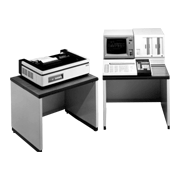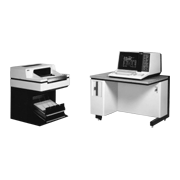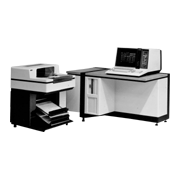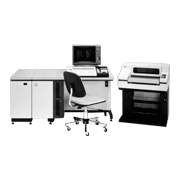The USAC System 11 was an office computer (a small business computer used in an office) from Uchida Yoko which was announced in April 1979 as the successor of the USAC 820 ultra-small computer. This machine was designed as a true office computer which could be set up anywhere in an office, and easily operated by anyone when necessary, just as though they were working with an office machine. To disseminate this computer as a business machine, it was connected to a multi-functional display unit, and to a multi-purpose printer based on a completely new concept -- with automatic paper feed for both continuous and single-sheet forms, and an ID mark printing/reading mechanism. In this way, the machine was announced as the first step in the evolution of office information systems in the 1980s. This machine had the following features:
(1) It employed the industry's first large-scale (10,000 gate) CMOS LSI processor (FSSP(FSSP(*1)) as a common engine for subsequently developed models.
(2) A Japanese language system was standard.
(3) Memory capacity was greatly enhanced by using high-density memory elements.
This made it possible to provide a true OS to achieve multi-job processing and Japanese language processing.
The USAC System 7 was announced in 1980, the following year. This was the first machine in Japan with an 8-inch microdisk (a compact, high-performance disk unit employing an 8-inch disk developed based on a new concept). The System 7 evolved into later members of the series (the USAC System 5, 9 and 21) which incorporated new technology like high-capacity microdisks.
In 1981, Uchida Yoko announced the desktop type USAC System 3, which employed the i8086 CPU.
The USAC Camarade was the first office computer equipped with a 5-inch mini floppy disk, and this model was added in 1982, thus completing a Series lineup which could meet user requirements over a wide range of scales. The USAC Camarade was announced as a business computer, but since it was built based on the USAC System 3, and its successor (the New Camarade) was treated as an office computer, it is treated here as an office computer.
*1: Fujitsu Small System Processor
| Model name | USAC System 11 | USAC System 7 | USAC System 5,9,21 | USAC System 3 (Camarade) | |
|---|---|---|---|---|---|
| Announcement date | April 1979 | May 1980 | May 1982 | October 1981 (December 1982) | |
| CPU | 16bit CMOS LSI processor (FSSP) Memory address space 16MB, virtual address system, microprogram control |
16bit microprocessor i8086 (8MHz) | |||
| System memory mechanism | Memory element | 16K/64Kbit MOS-LSI | 64Kbit MOS-LSI | 256Kbit MOS-LSI | |
| Memory capacity | 256--512KB | Standard type 192--384KB Japanese language type 256--384KB |
System 5: 256KB--512KB System 9: 384KB--1MB System 21: 84KB--1.5MB |
256/384 /512KB (Camarade: 256KB) |
|
| Error checking | ECC (1bit error correction, 2bit error detection) |
Parity check | |||
| Built-in magnetic disk | 14inch 20.2/40.4 /105.9MB |
8inch x1 10/20MB |
8inch System 5: 20/40MB x1 System 9: 20/40MB x2 (Max.) System 21: 67--268MB x4 (Max.) |
Type with disk, 5inch 7.5MB x1 (initially had no disk) (Camarade: No disk) |
|
| Built-in floppy disk unit | 8inch 243KB (1S), 1.2MB (2D), 1 drive (Standard) | 8inch 243KB (1S), 1.2MB (2D), 1 drive (Standard) | 8inch (thin type) 1.2MB System 5, 9: 1 System 21: 1--2 |
8inch 1.2MB, 4 drives max. (Camarade: 1inch 1MB minifloppy x2--3) |
|
| Number of connected workstations (display + printer) | 8 | none | System 5: None System 9: 4 System 21: 28 |
none | |
| Equipment type | Standalone | Standalone (System 5: desktop) | Desktop | ||
(Note) The above specifications are from the time of announcement, and may have been changed due to later improvement.





